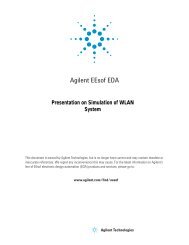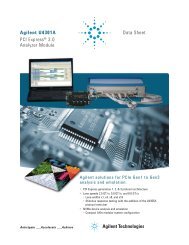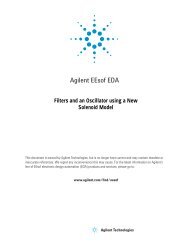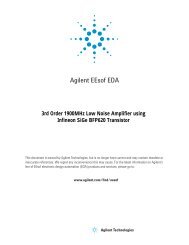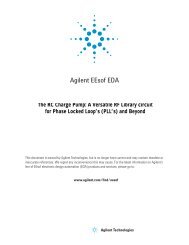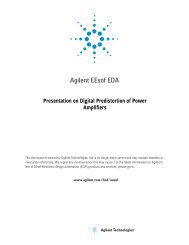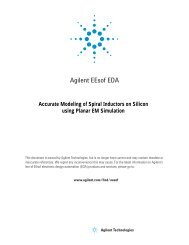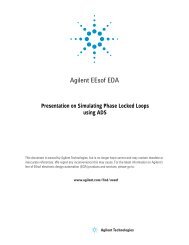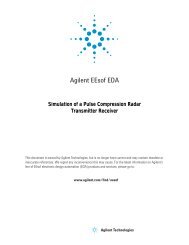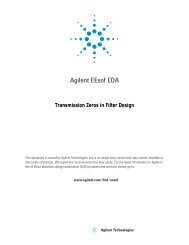3GPP LTE: Introducing Single-Carrier FDMA - Agilent Technologies
3GPP LTE: Introducing Single-Carrier FDMA - Agilent Technologies
3GPP LTE: Introducing Single-Carrier FDMA - Agilent Technologies
Create successful ePaper yourself
Turn your PDF publications into a flip-book with our unique Google optimized e-Paper software.
<strong>3GPP</strong> <strong>LTE</strong>:<br />
<strong>Introducing</strong><br />
<strong>Single</strong>-<strong>Carrier</strong><br />
<strong>FDMA</strong><br />
Moray Rumney BSc, C. Eng, MIET<br />
Lead Technologist, <strong>Agilent</strong> <strong>Technologies</strong><br />
moray_rumney@agilent.com<br />
1 <strong>Agilent</strong> Measurement Journal
Close on the heels of IEEE’s new 802.16e standard—better<br />
known as Mobile WiMAX TM — follows the response from the<br />
Third-Generation Partnership Project (<strong>3GPP</strong>) in the form of its<br />
Long-Term Evolution (<strong>LTE</strong>) project. We featured WiMAX TM<br />
in Issue Three of <strong>Agilent</strong> Measurement Journal and in this<br />
article we explore what <strong>LTE</strong> aims to bring to the wireless<br />
ecosystem. After considering the broader aspects of <strong>LTE</strong>, we<br />
take a closer look at the uplink, which uses a new modulation<br />
format called single-carrier frequency-division multiple access<br />
(SC-<strong>FDMA</strong>). These are interesting times because it is rare that<br />
the communications industry rolls out a new modulation format.<br />
From both a technical and practical point of view, there is much<br />
to understand, examine and evaluate in the capabilities and<br />
benefi ts that SC-<strong>FDMA</strong> brings to <strong>LTE</strong>. SC-<strong>FDMA</strong> is a hybrid<br />
modulation scheme that combines the low peak-to-average<br />
ratio (PAR) of traditional single-carrier formats such as GSM<br />
with the multipath resistance and in-channel frequency<br />
scheduling fl exibility of orthogonal frequency-division<br />
multiplexing (OFDM).<br />
Acronyms galore: <strong>LTE</strong> history and context<br />
<strong>LTE</strong>’s study phase began in late 2004. The overall goal was to<br />
select technology that would keep <strong>3GPP</strong>’s Universal Mobile<br />
Telecommunications System (UMTS) at the forefront of mobile<br />
wireless well into the next decade. Key project objectives were<br />
set in the following areas: peak data throughput; spectral<br />
effi ciency; fl exible channel bandwidths; latency; device<br />
complexity; and overall system cost. The main decision was<br />
whether to pursue the objectives by continuing to evolve the<br />
existing W-CDMA air interface (which incorporates HSPA*) or<br />
adopt a new air interface based on OFDM. At the conclusion<br />
of the study phase, <strong>3GPP</strong> decided that the project objectives<br />
could not be entirely met by evolving HSPA. As a result, the <strong>LTE</strong><br />
evolved radio access network (RAN) is based on a completely<br />
new OFDM air interface.<br />
This does not mean the end of <strong>3GPP</strong>’s interest in GSM and<br />
W-CDMA. Rather, the investment in these technologies — and<br />
their remaining untapped potential — means that <strong>LTE</strong> is not the<br />
only format being developed in <strong>3GPP</strong> Release 8. For example,<br />
the EDGE Evolution project will be pushing GSM to newer levels<br />
and the HSPA+ project — the runner-up to OFDM for <strong>LTE</strong><br />
— will continue to evolve the underlying W-CDMA, HSDPA<br />
and HSUPA technologies. For an overview of how these formats<br />
inter-relate, please see “What Next for Mobile Telephony?”<br />
in Issue Three of <strong>Agilent</strong> Measurement Journal.<br />
By using OFDM, <strong>LTE</strong> is aligning with similar decisions made by<br />
<strong>3GPP</strong>2 for Ultra-Mobile Broadband (UMB) and by IEEE 802.16<br />
for WiMAX. For an overview of OFDM technology, please see<br />
“Understanding the Use of OFDM in IEEE 802.16 (WiMAX)” in<br />
Issue Two of <strong>Agilent</strong> Measurement Journal. Although the article<br />
explains the basics of OFDM with reference to WiMAX, the<br />
general principles apply to <strong>LTE</strong> and UMB as well.<br />
Within the formal <strong>3GPP</strong> specifi cations, the <strong>LTE</strong> evolved RAN is<br />
split into two parts: the Evolved UMTS Terrestrial Radio Access<br />
(E-UTRA) describing the mobile part; and the Evolved UMTS<br />
Terrestrial Radio Access Network (E-UTRAN) for the base<br />
station. For simplicity, this article refers to the new air interface<br />
by its project name, <strong>LTE</strong>. This is becoming common usage just as<br />
happened with another project name, UMTS, which has been<br />
synonymous with W-CDMA since 1999. In addition to developing<br />
<strong>LTE</strong>, <strong>3GPP</strong> is also working on a complementary project known<br />
as System Architecture Evolution (SAE), which defi nes the split<br />
between <strong>LTE</strong> and a new Evolved Packet Core (EPC), which is a<br />
fl atter packet-only core network that aims to deliver the higher<br />
throughput, lower cost and lower latency promised by <strong>LTE</strong>. The<br />
EPC is also designed to provide seamless interworking with<br />
existing <strong>3GPP</strong> and non-<strong>3GPP</strong> access technologies.<br />
*HSPA (high-speed packet access) refers collectively to high-speed downlink packet<br />
access (HSDPA) and high-speed uplink packet access (HSUPA), the latter being<br />
formally known as the Enhanced Dedicated Channel (E-DCH).<br />
www.agilent.com/go/journal<br />
<strong>Agilent</strong> Measurement Journal 2
<strong>LTE</strong> objectives and timing<br />
The sidebar <strong>LTE</strong> at a glance (page 25) describes the major<br />
objectives of the <strong>LTE</strong> project and some of the key system<br />
attributes. Figure 1 shows an overall timeline for the <strong>LTE</strong><br />
project. Compared to UMTS, the overall timescale is shorter,<br />
due largely to a much smoother standardization process. The<br />
development of <strong>LTE</strong> will avoid the 8000-plus change requests<br />
ultimately applied over a four-year period to the “frozen” UMTS<br />
Release 99 specifi cations. The instability and subsequent delays<br />
in the UMTS standard led to commercial deployment of a<br />
proprietary system in Japan before the worldwide standard was<br />
available. It is expected that the surprises and delays of UMTS<br />
will be averted with <strong>LTE</strong>, meaning its introduction should be<br />
more predictable and better able to avoid a proprietary launch.<br />
The dates in Figure 1 are acknowledged as aggressive and may<br />
slip; however, progress is solid and, as UMTS proved, trying to<br />
rush the process can be counterproductive.<br />
OFDM: The choice of<br />
next-generation wireless<br />
With <strong>LTE</strong> joining UMB and WiMAX in choosing OFDM as the<br />
underlying modulation technology, it could be argued that<br />
there is now little to choose between these cellular systems.<br />
Of the fi ve major new cellular systems, only HSPA+ and EDGE<br />
Evolution do not use OFDM, a difference clearly driven by the<br />
practical need for backwards compatibility with their respective<br />
installed bases.<br />
OFDM has been around since the mid 1960s and is now used in<br />
a number of non-cellular wireless systems such as Digital Video<br />
Broadcast (DVB), Digital Audio Broadcast (DAB), Asymmetric<br />
Digital Subscriber Line (ADSL) and some of the 802.11 family of<br />
Wi-Fi standards. In contrast, it has taken longer for OFDM to be<br />
adopted into cellular standards: It was briefl y evaluated in the<br />
late 1980s during the early stages of GSM and again a decade<br />
later as a candidate technology for UMTS but was not adopted<br />
in either case. The primary issue was the processing power<br />
needed to perform the fast Fourier transform (FFT) operations<br />
at the heart of OFDM. In the ’80s and ’90s, suitable processors<br />
were too expensive and power-hungry for mobile applications.<br />
Since then, Moore’s Law has come to the rescue for fi rst<br />
WiMAX then UMB and now <strong>LTE</strong>.<br />
Assessing the advantages of OFDM<br />
The primary advantage of OFDM is its resistance to the damaging<br />
effects of multipath delay spread (fading) in the radio channel.<br />
Without multipath protection, the symbols in the received signal<br />
can overlap in time, leading to inter-symbol interference (ISI).<br />
In OFDM systems designed for use in multipath environments,<br />
ISI can be avoided by inserting a guard period, known as the<br />
cyclic prefi x (CP), between each transmitted data symbol. The<br />
CP is a copy of the end of the symbol inserted at the beginning.<br />
By sampling the received signal at the optimum time, the<br />
receiver can avoid all ISI caused by delay spread up to the<br />
length of the CP.<br />
2005 2006 2007 2008 2009 2010<br />
Rel-7 Study phase<br />
Rel-8 Work phase<br />
Test specs<br />
Core<br />
specs<br />
drafted<br />
First<br />
test<br />
specs<br />
First UE<br />
certification?<br />
First<br />
commercial<br />
release<br />
Figure 1. <strong>LTE</strong> timing<br />
3 <strong>Agilent</strong> Measurement Journal www.agilent.com/go/journal
The CP is chosen to be slightly longer than the longest expected<br />
delay spread in the radio channel. For the cellular <strong>LTE</strong> system,<br />
the standard CP length has been set at 4.69 µs, enabling the<br />
system to cope with path delay variations up to about 1.4 km.<br />
Note that this fi gure represents the difference in path length<br />
due to refl ections, not the size of the cell.* Inserting a CP<br />
between every symbol reduces the data handling capacity of<br />
the system by the ratio of the CP to the symbol length. For <strong>LTE</strong>,<br />
the symbol length is 66.7 µs, which gives a small but signifi cant<br />
seven percent loss of capacity when using the standard CP.<br />
The ideal symbol length in OFDM systems is defi ned by the<br />
reciprocal of the subcarrier spacing and is chosen to be long<br />
compared to the expected delay spread. <strong>LTE</strong> has chosen<br />
15 kHz subcarrier spacing, giving 66.7 µs for the symbol length.<br />
In a single-carrier system, the symbol length is closely related<br />
to the occupied bandwidth. For example, GSM has 200 kHz<br />
channel spacing and a 270.833 ksps symbol rate, giving a<br />
3.69 µs symbol length that is 18 times shorter than that of <strong>LTE</strong>.<br />
In contrast, W-CDMA has 5 MHz channel spacing and a<br />
3.84 Msps symbol rate, producing a 0.26 µs symbol length<br />
— 256 times shorter than <strong>LTE</strong>. It would be impractical to insert<br />
a 4.69 µs CP between such short symbols because capacity<br />
would drop by more than half with GSM and by a factor of<br />
20 with W-CDMA. Systems that use short symbol lengths<br />
compared to the delay spread must rely on receiver-side<br />
channel equalizers to recover the original signal.<br />
The link between channel bandwidth and symbol length puts<br />
single-carrier systems at a disadvantage versus OFDM when<br />
the channel bandwidths get wider. Consider a radio channel<br />
with 1 µs of delay spread: A 5 MHz single-carrier signal would<br />
experience approximately fi ve symbols of ISI and a 20 MHz<br />
signal would experience approximately 20 symbols of ISI. The<br />
amount of ISI determines how hard the equalizer has to work<br />
and there exists a practical upper limit of about 5 MHz beyond<br />
which equalizer costs rise and performance drops off.<br />
Each 15 kHz subcarrier in <strong>LTE</strong> is capable of transmitting 15 ksps,<br />
giving <strong>LTE</strong> a raw symbol rate of 18 Msps at its 20 MHz system<br />
bandwidth (1200 subcarriers, 18 MHz). Using 64QAM — the<br />
most complex of the <strong>LTE</strong> modulation formats — in which one<br />
symbol represents six bits, the raw capacity is 108 Mbps.<br />
Note that actual peak rates as described in the <strong>LTE</strong> sidebar are<br />
derived by subtracting coding and control overheads and adding<br />
gains from features such as spatial multiplexing.<br />
OFDM’s other main advantage over single-carrier systems is the<br />
ease with which it can adapt to frequency and phase distortions in<br />
the received signal, whether caused by transmitter impairments or<br />
radio-channel imperfections. Transmitted and received signals<br />
are represented in the frequency domain by subcarrier phase<br />
and amplitude. By seeding the transmitted signal across the<br />
frequency domain with many reference signals (RS, known in<br />
other systems as pilots) of predetermined amplitude and phase,<br />
the receiver can easily correct for frequency-dependent signal<br />
distortions prior to demodulation. This correction is particularly<br />
necessary when using higher-order modulation formats (e.g.,<br />
16QAM, 64QAM) that are susceptible to erroneous symbol<br />
demodulation caused by even small errors in phase<br />
and amplitude.<br />
This ability to easily manipulate phase and frequency also lends<br />
itself to the processing required for multiple-input/multipleoutput<br />
(MIMO) antenna techniques such as spatial multiplexing<br />
and beamforming. The required manipulations of signal phase<br />
and amplitude are much easier to implement in OFDM systems<br />
than in single-carrier systems, which represent signals in the<br />
time domain.<br />
To summarize the advantages, OFDM systems transmit multiple<br />
low-rate subcarriers — resistant to multipath — that combine<br />
by the hundreds and thousands to provide a truly scalable<br />
system bandwidth and associated data rates. In addition,<br />
the frequency-domain representation of signals simplifi es<br />
the correction of signal errors in the receiver and reduces the<br />
complexity of MIMO implementation. By contrast, single-carrier<br />
systems do not scale well with bandwidth and are impractical<br />
at much above 5 MHz if path delay differences are long.<br />
*Longer CP lengths are available for use in larger cells and for specialist multi-cell<br />
broadcast applications. This provides protection for up to 10 km delay spread but<br />
with a proportional reduction in the achievable data rates.<br />
www.agilent.com/go/journal<br />
<strong>Agilent</strong> Measurement Journal 4
Examining the disadvantages of OFDM<br />
OFDM has two big disadvantages when compared to singlecarrier<br />
systems. First, as the number of subcarriers increases,<br />
the composite time-domain signal starts to look like Gaussian<br />
noise, which has a high peak-to-average ratio (PAR) that can<br />
cause problems for amplifi ers. Allowing the peaks to distort<br />
is unacceptable because this causes spectral regrowth in the<br />
adjacent channels. Modifying an amplifi er to avoid distortion<br />
often requires increases in cost, size and power consumption.<br />
There exist techniques to limit the peaks (e.g., clipping and tone<br />
reservation*) but all have limits and can consume signifi cant<br />
processing power while degrading in-channel signal quality.<br />
The other main disadvantage of OFDM systems is caused by<br />
tight spacing of subcarriers. To minimize the lost effi ciency<br />
caused by inserting the CP, it is desirable to have very long<br />
symbols, which means closely spaced subcarriers; however,<br />
apart from increasing the required processing, close subcarriers<br />
start to lose their orthogonality (independence from each other)<br />
due to frequency errors. Three key problems associated with<br />
close subcarriers cause lost performance. First, any frequency<br />
error in the receiver will cause energy from one subcarrier’s<br />
symbol to interfere with the next. Second, phase noise in the<br />
received signal causes similar ISI in the subcarriers but on both<br />
sides. Third, Doppler shift can cause havoc. It is easy to remove<br />
a fi xed Doppler shift but consider the case when multipath is<br />
involved and signals are arriving at the receiver from both front<br />
and back: The received signals are shifted both higher and<br />
lower in frequency and it takes considerable processing power<br />
to recover the original signal. To balance the desire for long<br />
symbols with the problems caused by close subcarrier<br />
spacing, <strong>LTE</strong> has adopted 15 kHz spacing, with a narrower<br />
7.5 kHz chosen for use with <strong>LTE</strong>’s solution for mobile TV, the<br />
evolved Multimedia Broadcast Multicast Service (eMBMS). 1<br />
<strong>Introducing</strong> SC-<strong>FDMA</strong><br />
The undesirable high PAR of OFDM led <strong>3GPP</strong> to choose a<br />
different modulation format for the <strong>LTE</strong> uplink. This difference<br />
contributed to the inability of TTA, the Korean standards body,<br />
to persuade <strong>3GPP</strong> (in 2006) to merge <strong>LTE</strong> and WiMAX. Pure<br />
OFDM is used in the WiMAX uplink but <strong>LTE</strong> continued to use<br />
SC-<strong>FDMA</strong>, a new hybrid modulation scheme that cleverly combines<br />
the low PAR of single-carrier systems with the multipath<br />
resistance and fl exible subcarrier frequency allocation offered<br />
by OFDM.<br />
When a new concept in modulation comes along (e.g., OFDM<br />
or CDMA), it can take a long time before the literature starts to<br />
make sense. Yet, after everyone “gets it,” we often look back<br />
at what previously seemed to be impenetrable explanations<br />
and wonder what the fuss was about! So it may be with<br />
SC-<strong>FDMA</strong>. The Release 8 <strong>3GPP</strong> specifi cations do little to<br />
explain the concept. For a formal defi nition of SC-<strong>FDMA</strong>,<br />
a student of signal processing need look no further than<br />
TS 36.211, which gives the mathematical description of the<br />
time-domain representation of an SC-<strong>FDMA</strong> symbol. 2 For the<br />
majority of us who fi nd the formal mathematical approach hard<br />
to follow, we will present here a graphical comparison of the<br />
differences between OFDM and SC-<strong>FDMA</strong>.<br />
Comparing OFDM and SC-<strong>FDMA</strong><br />
Figure 2 shows how a series of QPSK symbols are mapped into<br />
time and frequency by the two different modulation schemes.<br />
Rather than using OFDM, we will now shift to the term O<strong>FDMA</strong>,<br />
which stands for orthogonal frequency-division multiple access.<br />
O<strong>FDMA</strong> is simply an elaboration of OFDM used by <strong>LTE</strong> and<br />
other systems that increases system fl exibility by multiplexing<br />
multiple users onto the same subcarriers. This can benefi t the<br />
effi cient trunking of many low-rate users onto a shared channel<br />
as well as enable per-user frequency hopping to mitigate the<br />
effects of narrowband fading. For clarity, the example here<br />
uses only four (N) subcarriers over two symbol periods with the<br />
payload data represented by QPSK modulation. Real <strong>LTE</strong> signals<br />
are allocated in units of 12 adjacent subcarriers (180 kHz) called<br />
resource blocks that last for 0.5 ms and usually contain seven<br />
symbols whose modulation can be QPSK, 16QAM or 64QAM.<br />
*Tone reservation is an advanced form of clipping in which the time-domain signal is<br />
shaped such that the error energy falls on specific, reserved in-channel frequencies,<br />
ensuring less distortion in the wanted part of the signal.<br />
5 <strong>Agilent</strong> Measurement Journal www.agilent.com/go/journal
-1, 1<br />
Q<br />
1, 1<br />
1, 1 -1, -1 -1, 1 1, -1 1, 1 -1, -1 -1, 1 1, -1<br />
I<br />
Sequence of QPSK data symbols to be transmitted<br />
-1, -1<br />
1, -1<br />
QPSK modulating<br />
data symbols<br />
V<br />
Time<br />
O<strong>FDMA</strong><br />
symbol<br />
CP<br />
O<strong>FDMA</strong><br />
symbol<br />
V<br />
Time<br />
SC-<strong>FDMA</strong><br />
symbol<br />
CP<br />
SC-<strong>FDMA</strong><br />
symbol<br />
f c 15 kHz Frequency<br />
O<strong>FDMA</strong><br />
Data symbols occupy 15 kHz for<br />
one O<strong>FDMA</strong> symbol period<br />
f c<br />
60 kHz<br />
Frequency<br />
SC-<strong>FDMA</strong><br />
Data symbols occupy N x 15 kHz for<br />
1/N SC-<strong>FDMA</strong> symbol periods<br />
Figure 2. Comparison of how O<strong>FDMA</strong> and SC-<strong>FDMA</strong> transmit a sequence of QPSK data symbols<br />
The <strong>LTE</strong> downlink uses traditional O<strong>FDMA</strong> methods and differs<br />
from other systems such as UMB and WiMAX only in details<br />
of the OFDM numerology (that is subcarrier spacing, symbol<br />
length, bandwidth, etc.). On the left side of Figure 2, N adjacent<br />
15 kHz subcarriers — already positioned at the desired place<br />
in the channel bandwidth — are each modulated for the<br />
O<strong>FDMA</strong> symbol period of 66.7 µs by one QPSK data symbol.<br />
In this simple four-subcarrier example, four symbols are taken<br />
in parallel. These are QPSK data symbols so only the phase of<br />
each subcarrier is modulated and the subcarrier power remains<br />
constant between symbols. After one O<strong>FDMA</strong> symbol period<br />
has elapsed, the CP is inserted and the next four symbols are<br />
transmitted in parallel. For visual clarity, the CP is shown as a<br />
gap; however, it is actually fi lled with a copy of the end of the<br />
next symbol, meaning the transmission power is continuous but<br />
has a phase discontinuity at the symbol boundary. To create the<br />
transmitted signal, an inverse FFT is performed on each subcarrier<br />
to create N time-domain signals that are vector summed to<br />
create the fi nal time-domain waveform used for transmission.<br />
SC-<strong>FDMA</strong> signal generation begins with a special precoding<br />
process but then continues as with O<strong>FDMA</strong>. Before outlining<br />
the generation process it is helpful to first describe the end<br />
result as shown on the right side of Figure 2. The most obvious<br />
difference between the two schemes is that O<strong>FDMA</strong> transmits<br />
the four QPSK data symbols in parallel, one per subcarrier, while<br />
SC-<strong>FDMA</strong> transmits the four QPSK data symbols in series at four<br />
times the rate, with each data symbol occupying N x 15 kHz bandwidth.<br />
Visually, the O<strong>FDMA</strong> signal is clearly multi-carrier and the<br />
SC-<strong>FDMA</strong> signal looks more like single-carrier, which explains<br />
the “SC” in its name. Note that O<strong>FDMA</strong> and SC-<strong>FDMA</strong> symbol<br />
lengths are the same at 66.7 µs; however, the SC-<strong>FDMA</strong> symbol<br />
contains N “sub-symbols” that represent the modulating data.<br />
It is the parallel transmission of multiple symbols that creates<br />
the undesirable high PAR of O<strong>FDMA</strong>. By transmitting the N data<br />
symbols in series at N times the rate, the SC-<strong>FDMA</strong> occupied<br />
bandwidth is the same as multi-carrier O<strong>FDMA</strong> but — crucially<br />
— the PAR is the same as that used for the original data<br />
symbols. This should make heuristic sense without delving<br />
into the mathematics: Adding together many narrowband<br />
QPSK waveforms in O<strong>FDMA</strong> will always create higher peaks<br />
than would be seen in the wider-bandwidth single-carrier<br />
QPSK waveform of SC-<strong>FDMA</strong>. As the number of subcarriers N<br />
increases, the PAR of O<strong>FDMA</strong> with random modulating data<br />
approaches Gaussian noise statistics but, regardless of the<br />
value of N, the SC-<strong>FDMA</strong> PAR remains the same as that used<br />
for the original data symbols.<br />
www.agilent.com/go/journal<br />
<strong>Agilent</strong> Measurement Journal 6
Having seen what SC-<strong>FDMA</strong> looks like, we will now explain the<br />
precoding process that brings it about. Figure 3 shows the fi rst<br />
steps, which create a time-domain waveform of the QPSK data<br />
sub-symbols. Using the four color-coded QPSK data symbols<br />
from Figure 2, the process creates one SC-<strong>FDMA</strong> symbol in the<br />
time domain by computing the trajectory traced by moving from<br />
one QPSK data symbol to the next. This is done at N times the<br />
rate of the SC-<strong>FDMA</strong> symbol such that one SC-<strong>FDMA</strong> symbol<br />
contains N consecutive QPSK data symbols. For simplicity,<br />
we will not discuss time-domain fi ltering of the data symbol<br />
transitions even though such fi ltering will be present in any real<br />
implementation.<br />
Having created an IQ representation in the time domain of one<br />
SC-<strong>FDMA</strong> symbol, the next stage is to represent it in the<br />
frequency domain using a discrete Fourier transform (DFT;<br />
Figure 4). The DFT sampling frequency is chosen such that<br />
the time-domain waveform of one SC-<strong>FDMA</strong> symbol is fully<br />
represented by N DFT bins spaced 15 kHz apart, with each bin<br />
representing one subcarrier with amplitude and phase held<br />
constant for 66.7 µs. There is always a one-to-one correlation<br />
between the number of data symbols to be transmitted during<br />
one SC-<strong>FDMA</strong> symbol period and the number of DFT bins<br />
created — and this in turn becomes the number of occupied<br />
subcarriers. This should make intuitive sense: When an increasing<br />
number of data symbols is transmitted during one SC-<strong>FDMA</strong><br />
period, the time-domain waveform changes faster, generating<br />
a higher bandwidth and hence requiring more DFT bins to fully<br />
represent the signal in the frequency domain.<br />
Note from Figure 4 that there is no longer a direct relationship<br />
between the amplitude and phase of the individual DFT bins<br />
and the original QPSK data symbols. This is quite different from<br />
the O<strong>FDMA</strong> example in which data symbols directly modulate<br />
the subcarriers.<br />
The next stage is to shift the baseband DFT representation of<br />
the time-domain SC-<strong>FDMA</strong> symbol to the desired part of the<br />
overall channel bandwidth. Because the signal is now represented<br />
as a DFT, frequency shifting is a very simple process<br />
achieved by copying the N bins into a larger DFT space that can<br />
be up to the size of the system channel bandwidth — of which<br />
there are six to choose from in <strong>LTE</strong>, spanning 1.4 MHz to<br />
20 MHz. The elegance of the DFT lets us position the signal<br />
anywhere in the channel bandwidth, thus executing the<br />
frequency-division multiple access (<strong>FDMA</strong>) essential for<br />
effi ciently sharing the uplink between multiple users. *This<br />
explains the origin of the latter portion of “SC-<strong>FDMA</strong>.”<br />
-1, 1<br />
Q<br />
1, 1<br />
+1<br />
V(I)<br />
+1<br />
V(Q)<br />
Figure 3. Creating the<br />
time-domain waveform<br />
of an SC-<strong>FDMA</strong> symbol<br />
I<br />
-1, -1<br />
1, -1<br />
-1<br />
One SC-<strong>FDMA</strong><br />
symbol period<br />
-1<br />
One SC-<strong>FDMA</strong><br />
symbol period<br />
Figure 4. Baseband and<br />
shifted frequency domain<br />
representations of an<br />
SC-<strong>FDMA</strong> symbol<br />
Frequency<br />
Frequency<br />
*Although <strong>3GPP</strong> did consider a distributed form of subcarrier allocation for the<br />
uplink that would have alleviated susceptibility to narrowband fading, it instead<br />
opted for the adjacent allocation described here combined with the possibility of<br />
frequency hopping at the slot (0.5 ms) level.<br />
7 <strong>Agilent</strong> Measurement Journal www.agilent.com/go/journal
To conclude SC-<strong>FDMA</strong> signal generation, the process follows<br />
the same steps as for O<strong>FDMA</strong>. Performing an inverse FFT<br />
converts the frequency-shifted signal to the time domain and<br />
inserting the CP provides O<strong>FDMA</strong>’s fundamental robustness<br />
against multipath.<br />
If we now return to Figure 2’s representation of O<strong>FDMA</strong><br />
and SC-<strong>FDMA</strong>, we can consider how each signal would look<br />
depending on the analysis bandwidth. Table 1 summarizes the<br />
differences between the modulation formats.<br />
Table 1. Analysis of O<strong>FDMA</strong> and SC-<strong>FDMA</strong> at different bandwidths<br />
When analyzed one subcarrier at a time, O<strong>FDMA</strong> resembles the<br />
original data symbols. At full bandwidth, however, the signal<br />
looks like Gaussian noise in terms of its PAR statistics and the<br />
constellation. The opposite is true for SC-<strong>FDMA</strong>. Its relationship<br />
to the original data symbols is evident when analyzing the entire<br />
signal bandwidth whereupon the constellation (and hence low<br />
PAR) of the original data symbols can be observed rotating at<br />
N times the SC-<strong>FDMA</strong> symbol rate (ignoring the seven percent<br />
rate reduction due to adding the CP). When analyzed at the<br />
subcarrier bandwidth, the SC-<strong>FDMA</strong> PAR and constellation<br />
are meaningless because these are N times narrower than the<br />
information bandwidth of the data symbols.<br />
Modulation O<strong>FDMA</strong> SC-<strong>FDMA</strong><br />
format<br />
Analysis 15 kHz Signal BW 15 kHz Signal BW<br />
bandwidth (N x 15 kHz) (N x 15 kHz)<br />
Peak-to-average Same as High PAR Not meaningful Same as<br />
power ratio data symbol (Gaussian) (< data symbol) data symbol<br />
Observable Same as Not meaningful Not meaningful Same as<br />
IQ data symbol at (Gaussian) (< data symbol) data symbol at<br />
constellation 66.7 µs rate N x 66.7 µs rate<br />
<strong>LTE</strong> at a glance<br />
November 2004 <strong>LTE</strong>/SAE<br />
High-level requirements<br />
• Reduced cost per bit<br />
• More lower-cost services with better user experience<br />
• Flexible use of new and existing frequency bands<br />
• Simplifi ed lower-cost network with open interfaces<br />
• Reduced terminal complexity and reasonable power<br />
consumption<br />
Speed<br />
Downlink peak data rates (64QAM)<br />
Antenna confi guration SISO 2x2 MIMO 4x4 MIMO<br />
Peak data rate (Mbps) 100 172.8 326.4<br />
Uplink peak data rates (single antenna)<br />
Modulation depth QPSK 16QAM 64QAM<br />
Peak data rate (Mbps) 50 57.6 86.4<br />
Flexible channel bandwidths<br />
Bandwidth MHz Access mode<br />
1.4 FDD and TDD<br />
3 FDD and TDD<br />
5 FDD and TDD<br />
10 FDD and TDD<br />
15 FDD and TDD<br />
20 FDD and TDD<br />
The 1.6 MHz and 3.2 MHz TDD bandwidths have recently been deleted,<br />
and the six remaining bandwidths apply to both FDD and TDD.<br />
Mobility<br />
Optimized: 0 to 15 km/h<br />
High performance: 15 to 120 km/h<br />
Functional: 120 to 350 km/h<br />
Under consideration: 350 to 500 km/h<br />
Services<br />
Packet-switched voice and data. No circuit-switched<br />
services supported.<br />
Spectral Efficiency<br />
3-4x Rel-6 HSDPA (downlink)<br />
2-3x Rel-6 HSUPA (uplink)<br />
Latency<br />
Idle to active < 100 ms<br />
Small packets < 5 ms<br />
www.agilent.com/go/journal<br />
<strong>Agilent</strong> Measurement Journal 8
Figure 5. Analysis of a 16QAM SC-<strong>FDMA</strong> signal<br />
Multipath resistance with<br />
short data symbols?<br />
At this point it is reasonable to ask, “How can SC-<strong>FDMA</strong> still be<br />
resistant to multipath when the data symbols are still short?”<br />
In O<strong>FDMA</strong>, the modulating data symbols are constant over the<br />
66.7 µs O<strong>FDMA</strong> symbol period but an SC-<strong>FDMA</strong> symbol is not<br />
constant over time since it contains N sub-symbols of much<br />
shorter duration. The multipath resistance of the O<strong>FDMA</strong> demodulation<br />
process seems to rely on the long data symbols that<br />
map directly onto the subcarriers. Fortunately, it is the constant<br />
nature of each subcarrier — not the data symbols — that<br />
provides the resistance to delay spread. As shown earlier, the<br />
DFT of the time-varying SC-<strong>FDMA</strong> symbol generated a set of<br />
DFT bins constant in time during the SC-<strong>FDMA</strong> symbol period<br />
even though the modulating data symbols varied over the same<br />
period. It is inherent to the DFT process that the time-varying<br />
SC-<strong>FDMA</strong> symbol — made of N serial data symbols — is represented<br />
in the frequency domain by N time-invariant subcarriers.<br />
Thus, even SC-<strong>FDMA</strong> with its short data symbols benefi ts from<br />
multipath protection.<br />
It may seem counterintuitive that N time-invariant DFT bins can<br />
fully represent a time-varying signal. However, the DFT principle<br />
is simply illustrated by considering the sum of two fi xed sine<br />
waves at different frequencies: The result is a non-sinusoidal<br />
time-varying signal — fully represented by two fi xed<br />
sine waves.<br />
Examining a real SC-<strong>FDMA</strong> signal<br />
Figure 5 shows some of the measurements that can be made on<br />
a typical SC-<strong>FDMA</strong> signal. The constellation in trace A (top left)<br />
shows this is a 16QAM signal. The unity circle represents the<br />
RS (every seventh symbol), which do not use SC-<strong>FDMA</strong> but are<br />
phase modulated using an orthogonal Zadoff-Chu sequence. 3<br />
Trace B (lower left) shows the signal power versus frequency.<br />
The frequency scale is in 15 kHz subcarriers numbered from<br />
–600 to 599, which represents a bandwidth of 18 MHz. From<br />
this we can conclude this must be a 20 MHz channel and the<br />
allocated signal bandwidth is 5 MHz towards the lower end.<br />
The brown dots represent the instantaneous subcarrier amplitude<br />
and the white dots the average over 10 ms. In the center<br />
of the trace, the spike represents the LO leakage (IQ offset) of<br />
9 <strong>Agilent</strong> Measurement Journal www.agilent.com/go/journal
the signal; the large image to the right is an OFDM artifact deliberately<br />
created using 0.5 dB IQ gain imbalance in the signal.<br />
Both the LO leakage and the power in non-allocated subcarriers<br />
will be limited by the <strong>3GPP</strong> specifi cations.<br />
Trace C (top middle) shows a summary of the measured<br />
impairments including the error vector magnitude (EVM),<br />
frequency error and IQ offset. Note the data EVM at 1.15 percent<br />
is much higher than the RS EVM at 0.114 percent. This is due<br />
to a +0.1 dB boost in the data power as reported in trace E,<br />
which was ignored (for illustration) by the receiver to create<br />
data-specifi c EVM. Also note the RS power boost is reported<br />
as +1 dB, which can also be observed in the IQ constellation<br />
because the unity circle does not pass through eight of the<br />
16QAM points. Trace D (lower middle) shows the distribution<br />
of EVM by subcarrier. The average and peak of the allocated<br />
signal EVM is in line with the numbers in trace C. The EVM<br />
for the non-allocated subcarriers reads much higher although<br />
the way this in-channel impairment will be specifi ed will be as<br />
a power ratio between the wanted signal and the unwanted<br />
signal. The ratio for this signal is around 30 dB as can be seen in<br />
trace B. The blue dots in trace D also show the EVM of the RS,<br />
which is very low.<br />
Trace E (top right) shows the ability to measure EVM by<br />
modulation type from one capture. This signal uses only the RS<br />
phase modulation and 16QAM so the QPSK and 64QAM results<br />
are blank. Finally, trace F (lower right) shows the PAR — the<br />
whole point of SC-<strong>FDMA</strong> — in the form of a complementary<br />
cumulative distribution function (CCDF) measurement. It is not<br />
possible to come up with a single fi gure of merit for the PAR<br />
advantage of SC-<strong>FDMA</strong> over O<strong>FDMA</strong> because it depends<br />
on the data rate. The PAR of O<strong>FDMA</strong> is always higher than<br />
SC-<strong>FDMA</strong> even for narrow frequency allocations; however,<br />
when data rates rise and the frequency allocation gets wider,<br />
the SC-<strong>FDMA</strong> PAR remains constant but O<strong>FDMA</strong> gets worse<br />
and approaches Gaussian noise. A 5 MHz O<strong>FDMA</strong> 16QAM<br />
signal would look very much like Gaussian noise. From the white<br />
trace it can be seen at 0.01 percent probability the SC-<strong>FDMA</strong><br />
signal is 3 dB better than the Gaussian reference trace, and<br />
as every amplifi er designer knows, even a tenth of a decibel<br />
shaved from the peak power budget is money in the bank.<br />
Conclusion<br />
In essence, SC-<strong>FDMA</strong> means “create a single-carrier waveform<br />
and shift it to the desired part of the frequency domain.” After<br />
a careful consideration of the characteristics of O<strong>FDMA</strong> and<br />
the new SC-<strong>FDMA</strong>, we can conclude that SC-<strong>FDMA</strong> provides<br />
the advantages of O<strong>FDMA</strong> — especially robust resistance<br />
to multipath — without the problem of high PAR. The use of<br />
SC-<strong>FDMA</strong> in <strong>LTE</strong>, however, is restricted to the uplink because<br />
the increased time-domain processing would be a considerable<br />
burden on the base station, which has to manage the dynamics<br />
of multi-user transmission.<br />
It will be interesting to see if <strong>LTE</strong> — the latest of the three new<br />
O<strong>FDMA</strong> cellular standards — has indeed identifi ed a superior<br />
solution for the uplink or whether the pure O<strong>FDMA</strong> used in<br />
WiMAX or the O<strong>FDMA</strong>/CDMA combination used in UMB prove<br />
to be just as successful when all the factors are taken into<br />
account. Today, the experts disagree so we will have to wait<br />
on the ultimate arbiter, time, before we fi nd out for sure.<br />
References<br />
1. <strong>3GPP</strong> TS 36.201 v8.0.0 section 4.2.1<br />
2. <strong>3GPP</strong> TS 36.211 v8.0.0 subclause 5.6<br />
3. <strong>3GPP</strong> TS 36.211 v8.0.0 subclause 5.5<br />
“WiMAX,” “Mobile WiMAX” and “WiMAX Forum” are<br />
trademarks of the WiMAX Forum.<br />
www.agilent.com/go/journal<br />
Printed in U.S.A. January 1, 2008<br />
© <strong>Agilent</strong> <strong>Technologies</strong>, Inc. 2008<br />
5989-7898EN





